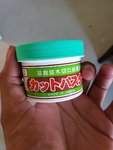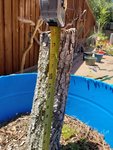dresdraconius
Yamadori
Hello Everyone.
Live from Zone 8a (Dallas, TX)
Someone wanted to get rid of live oak on Craigslist so I dug it up from their yard. It is about 8-9 feet tall from root stock to tip. I loved the trunk and how mature it appears.
Pre yamadori condition- I felt the tree wasn't thriving very well. Tips of branches were all bald and dry. No cambium at all. Trimmed these branches Please see picture where it is still in the ground.
Work done so far- Trimmed tap root off and most of the bigger roots. Left as much fibrous roots as I could. Currently potted with 50%- Pumice, lava and akadama and other 50% sifted hardwood mulch (from trees local to this area). Watering it like crazy for next few months and try to maximize the chances that it will root. Large holes at base of pot for aeration.
Immediate goals- Hoping the transplant wont kill tree and it takes.
Long term goals- Size it down (3-5 feet tall max) with as much resemblance to live oak as possible. I'll start working on increasing ramification next year or so.
From the forum members, I would like to request
1.Styling inputs.
2.When and where to chop, if at all required during next 12 months.
3. Any techniques to encourage budding from lower trunk so tree can appear 'fuller' once the top is chopped.
4. Anything else you want to add.
Disclaimers- Yes, I know this is stupid. I know 99.95% bonsai aren't this big. Please bear in mind, this is just a hobby to me. I am a noob trying to learn. I want to increase my collection of trees but I don't have the means to just go out and throw money on good looking trees. Please keep criticisms civil and if possible constructive.
Your time is much appreciated.
Live from Zone 8a (Dallas, TX)
Someone wanted to get rid of live oak on Craigslist so I dug it up from their yard. It is about 8-9 feet tall from root stock to tip. I loved the trunk and how mature it appears.
Pre yamadori condition- I felt the tree wasn't thriving very well. Tips of branches were all bald and dry. No cambium at all. Trimmed these branches Please see picture where it is still in the ground.
Work done so far- Trimmed tap root off and most of the bigger roots. Left as much fibrous roots as I could. Currently potted with 50%- Pumice, lava and akadama and other 50% sifted hardwood mulch (from trees local to this area). Watering it like crazy for next few months and try to maximize the chances that it will root. Large holes at base of pot for aeration.
Immediate goals- Hoping the transplant wont kill tree and it takes.
Long term goals- Size it down (3-5 feet tall max) with as much resemblance to live oak as possible. I'll start working on increasing ramification next year or so.
From the forum members, I would like to request
1.Styling inputs.
2.When and where to chop, if at all required during next 12 months.
3. Any techniques to encourage budding from lower trunk so tree can appear 'fuller' once the top is chopped.
4. Anything else you want to add.
Disclaimers- Yes, I know this is stupid. I know 99.95% bonsai aren't this big. Please bear in mind, this is just a hobby to me. I am a noob trying to learn. I want to increase my collection of trees but I don't have the means to just go out and throw money on good looking trees. Please keep criticisms civil and if possible constructive.
Your time is much appreciated.
Attachments
-
 00606_arCng8s0TVQ_0jm0pO_1200x900.jpg122.4 KB · Views: 326
00606_arCng8s0TVQ_0jm0pO_1200x900.jpg122.4 KB · Views: 326 -
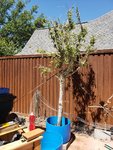 20200611_111956.jpg354.5 KB · Views: 321
20200611_111956.jpg354.5 KB · Views: 321 -
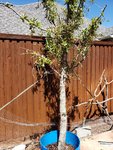 20200611_112031.jpg371.2 KB · Views: 278
20200611_112031.jpg371.2 KB · Views: 278 -
 20200611_112008.jpg381.8 KB · Views: 258
20200611_112008.jpg381.8 KB · Views: 258 -
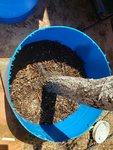 20200611_112351.jpg294.4 KB · Views: 243
20200611_112351.jpg294.4 KB · Views: 243 -
 20200611_111944.jpg335.7 KB · Views: 233
20200611_111944.jpg335.7 KB · Views: 233 -
 20200611_112008.jpg381.8 KB · Views: 201
20200611_112008.jpg381.8 KB · Views: 201

